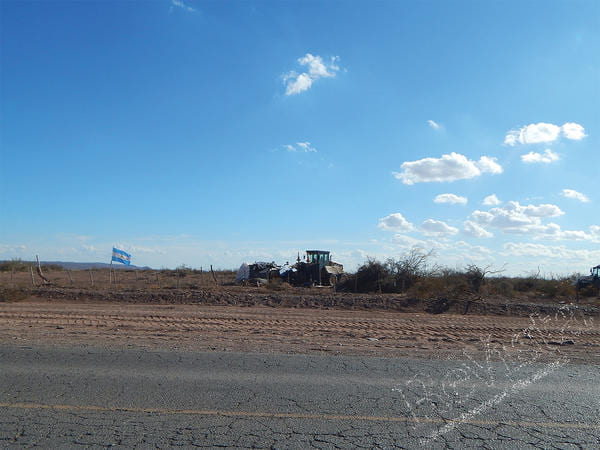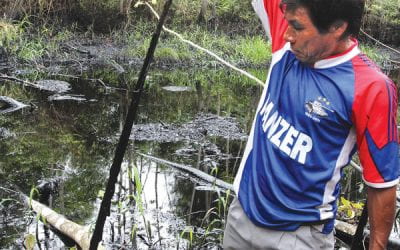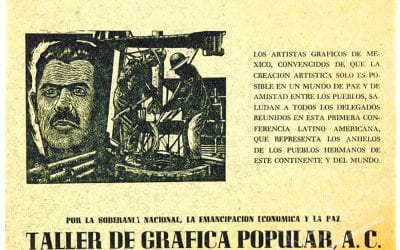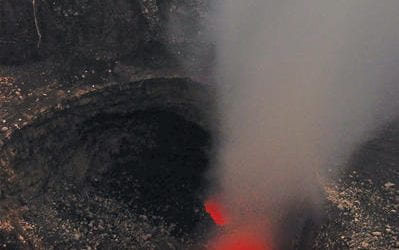Añelo and Vaca Muerta
Opportunity or Threat?

The Argentine flag flies on the lot of the makeshift house. A company truck stands in the field. Photo by Mariana Barrera.
Añelo, a once forgotten town 600 miles southwest of Buenos Aires, Argentina, is now in the middle of an oil boom as a result of the discovery of the Vaca Muerta shale field. My first experience there, in February 2014, was terrifying, and it plunged me right into Añelo’s way of life.
Añelo has an unusual and sharp geographic slope that splits the town into two areas with different altitudes. The industrial park and the new urban development are located on the high plateau. By the time I first visited the town, the upland was already cleaned of brush, smoothed and divided into lots for several oil companies that fenced in their areas where trucks and cranes operated. Signs along the side of the road pointed to exploration areas in Vaca Muerta, the world’s second largest shale gas reserve and fourth largest shale oil reserve.
Upon my arrival and after a five-hour interview in the local mayor’s office, he very kindly offered to drive me in his pickup to the town’s new industrial park. I immediately accepted his offer since my small car did not have enough power to make the climb on its own.
Along the way, the mayor told me about his expectations, projects and dreams for this part of the town. “Here’s where we are going to build the airport, ” he boasted. I found it hard to imagine an airport in the middle of this Patagonian desert; for now, highly congested, unpaved streets were the only signs of urban development. Meanwhile, just like every other researcher, I registered everything I saw with my camera. There was a lot with a company truck, a makeshift house, and an Argentine flag. I leaned out of the window of the mayor’s pickup and snapped a couple of shots. A woman came out of the house and shouted at us. We didn’t catch what she said, but the mayor kept on driving. He kept going for twenty more minutes, and once we reached the end of the industrial park, we headed back down the same road.
We drove by the lot where the woman had first screamed at us. Then the nightmare began. A bunch of people with sticks and stones were waiting for us. They spotted the pickup and ran towards us, blocking the road. The mayor had to stop driving. They surrounded the car and pelted windows with stones and sticks. The noise was deafening: the sticks, the stones, the glass and the screams.
The mayor decided to lower his side window; immediately, all the aggressors crowded around to his side. They shouted at him. Some of the sticks and stones were now landing inside the car. I decided to slide under the back seat, where I had been sitting, to protect my face and my camera. Eventually, the way was cleared. One of the mayor’s advisers asked him to leave quickly. The mayor obeyed, and we escaped unscathed. The front window of the pickup was destroyed, and my neck felt stiff.
Our next stop was the police station. The mayor filed a complaint, with me as a witness to the events. The news of the attack went viral in the local media under the heading “Añelo’s mayor was brutally assaulted.”
Since then, I’ve been back to Añelo a couple of more times, most recently in May 2015. I always ask about the people living in the makeshift house up in the industrial park and the mayor’s car—I can’t avoid feeling guilty about the broken window. The family had been displaced, and the insurance paid for the pickup’s front window. Yet I keep thinking that day’s events were a condensed example of what Añelo is experiencing since it turned into a boom town.
Vaca Muerta’s discovery put Añelo on the map in 2012. What used to be a forgotten pass-through town was rebranded as Argentina’s shale capital. Consequently, its simple governance structure suddenly became much more complex and tangled. While external stakeholders arrive in town attracted by the oil industry, local players change their behavior and demands as a result of the new opportunity. Despite their different goals, these stakeholders share the fact that their responses are driven by speculative interests, which translate into contesting agendas and, thus, potential conflicts.
The empowerment of local residents—rather than population growth—seems to be the major change in Añelo’s civil society. The coexistence of state ownership of the subsoil and private ownership of the land has encouraged local residents to raise their voices and make demands through blocking roads and oil production. Remarkably, their empowerment is limited. It’s undermined by the personal economic benefit promised by the resource boom. Añelo’s longtime residents agree almost unanimously not to oppose shale development because of job opportunities and development of new alternatives for income generation. Local residents are aware of their power to demand infrastructure and services, but they won’t risk their economic benefit because of it.
At the same time, the local private sector became more complex. The shale boom not only created incentives for local business owners to expand their activities, but also attracted outside companies interested in providing services to the oil industry. Walking around the town, I observed two new casinos, five hotels under construction and a huge commercial center about to be launched (45,000 square feet)—an amazing amount of space, it seems to me, for Añelo’s almost 6,000 residents. These new local businesses are attracted by the promise of profits associated with new consumer demands resulting from the cash-generating shale extraction in Vaca Muerta. Although these new businesses will become an integral part of urban life, they are not necessarily committed to promoting a sustainable development in town. The lack of urban regulation means they can arbitrarily change Añelo’s urban landscape without permits or consultation.
The shale boom also overwhelmed an understaffed and underfunded municipal government. The mayor’s schedule has become busier because of the many companies seeking to set up shop in Añelo. The mayor also opened a satellite office in Buenos Aires, Argentina’s capital city, to strengthen ties with the national government and with YPF, the national oil company. As a result, longtime residents often can’t reach the mayor by phone or by knocking on his door or window at city hall.
In more academic terms, Añelo’s mayor detached from his constituency by transforming the historical horizontal relationship into a top-down one, and leveraged the interaction with the private sector through one-time agreements (known as one-off). Private investment represents a fast and inexpensive way to increase service delivery and urban investment.
Changes in local governance are enhanced by stakeholder parachuting. In essence, this means that many different entities with often conflicting interests seek to pursue their own particular speculative goals. The national government, for one, found in Vaca Muerta the opportunity to solve its energy and fiscal crises. Likewise, Añelo and its new resources provide a solution to the fiscal deficit of the provincial administration, and give oil companies (including YPF) a chance to develop new revenue and business alternatives.
It’s important to highlight that stakeholder parachuting also has had positive effects on Añelo’s development. New stakeholders deliver significant resources for urban infrastructure and service provision. YPF, for instance, took the lead on bringing the International Development Bank on board for developing the town’s Master Plan 2030, a roadmap intended to prioritize investment needs. Unfortunately, the lack of urban regulation and planning institutions undermines the best way to take advantage of these opportunities. With his local advisors, the mayor chooses the projects to be developed in town, using common-sense criteria, along with considerations about funding and land availability. Yet in the face of an understaffed and underfunded local mayor influenced by other stakeholders such as oil companies and federal government, the inevitable question is who actually makes decisions and chooses the projects to be tackled in town.
This all brings me back to the threatening situation I encountered on my first visit and its reflection on the community impacts of living in a boom town. The lot I photographed illustrated some of the different stakeholders and competing rent-seeking interests coexisting in Añelo. On the one hand, without regulation or transparent criteria for the allocation, the oil company agreed with the mayor to settle on a specific lot to operate in Vaca Muerta, and started doing the work. On the other hand, empowered by the shale boom, the local family who settled in the makeshift house in the lot understood this as its opportunity to finally have its own land and house in town. After all, the industrial park was developed in municipal fiscal land.
In the absence of effective institutional mechanisms to channel both stakeholders’ claims, the overwhelmed mayor, as the local government representative, was responsible for arbitrating between them, but he couldn’t provide a solution. The lack of regulation and planning institutions undermined the ability to make clear decisions; this problem was also challenged by the lack of human and financial resources. I’m pretty sure that the family knew that the pickup was the mayor’s and that they proceeded to stone it because they could not find another way to make their voices heard. In a context of decentralization and a weak government, the result of these coexisting and competing rent-seeking interests was a critical and complex situation.
Since the shale boom, Añelo’s stakeholders are locked into complex relationships at the local level, characterized by jurisdictional voids and long-term choices made with short-term criteria and through one-off agreements. In a context of decentralization and weak government, local governance is undermined, leading to social and spatial exclusion in the town. The resource curse—the concept that dependence on non-renewable natural resources can cause a paradoxical negative impact on the economy—thus shows up at the local level.
The challenge should be to address this curse, and any effort to do it should do three things. As Uwafiokun Idemudia observes in his 2012 article in the Journal of Cleaner Production on the Resource Curse and the Decentralization of Oil Revenue, “…it must alter the opportunities and incentives for rent seeking, and (…) it should empower the majority of stakeholders ….” I believe it should also develop a common agenda among local and external stakeholders that should be embedded in collective priorities
For Añelo, the discovery of Vaca Muerta was the opportunity to be put on the map, and it brought the promise of a prosperous future. Waves of new actors and resources were (and are) attracted to town, increasing the hope for better times ahead. However, generalized rent-seeking interests in a context of weak governments seem to be transforming these opportunities into potential threats.
The good news is that this resource boom also brings the opportunity for innovating and developing better planning to address these opportunities and threats. In the particular case of Añelo, the discovery of Vaca Muerta represents the prospect of opening a conversation about how planning can be employed as a tool to avoid the resource curse at the sub-national level, and to translate resource discovery into better welfare for Argentina.
Fall 2015, Volume XV, Number 1
Mariana Barrera is an Argentine economist with a degree in finance who received a Master’s in Urban Planning from Harvard University in 2014. Funded by the Lincoln Institute of Land Policy, she leads a research project on Vaca Muerta’s urban development.
Related Articles
Oil and Indigenous Communities
On a drizzly morning in late February, a boat full of silent Kukama men motored slowly into the flooded forest off the Marañón River in northern Peru. Cutting the…
Mexico’s Energy Reform
The small, white-washed classroom at the University in Minatitlán, Veracruz, was packed with a couple dozen people who, although neighbors, had never met…
Geothermal Energy in Central America
When we think about global technology leaders, Central America does not typically come to mind. But Central American countries have indeed been in the…




